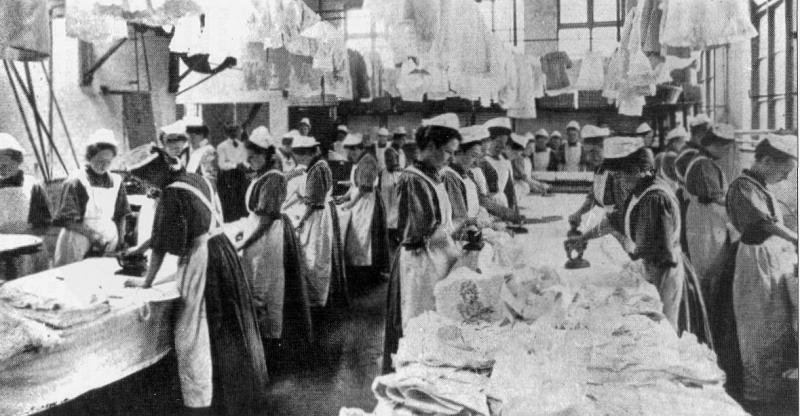Ok, so I know that the Sinead/Miley thing is old news, lying (by internet standards) in the distant past of November, 2013. You can feel free to remind yourself of it here. But seeing as one of my major points is about the repetitive nature of debates over women’s public sexuality, I’m sure it’s only a matter of time before this all becomes relevant again. History might not quite repeat itself, but it is often deeply unoriginal. Let me offer an example.
In the medieval and early modern periods, people had pretty harsh ideas about ‘fallen women’: women who had sex (and children) out of wedlock, women who were promiscuous, women who were kept as mistresses, and women who sold sex as prostitutes. These women were seen as people who should be punished: pilloried, mutilated, imprisoned, transported to a penal colony. But by the late eighteenth century, thinking had begun to change. These women should not be punished, more and more people felt: they should be protected from exploitation by men, and rehabilitated.

Trouble was, this protection and rehabilitation looked an awful lot like punishment. Women were protected by being told that they must be sexually passive: modest, chaste, and only engaging in sex within marriage. Women who had strayed from this path needed to be saved from themselves, and taught how to behave and also, conveniently, how to do other people’s laundry.
These reform homes for prostitutes could take many forms, but they were spartan and boring at best. Some of the worst were Ireland’s Magdalene laundries, where women were shamed, emotionally and physically abused, and punished for their ‘crimes’ of sexual promiscuity, prostitution, and pregnancy. These homes–reintroduced to the public through the 2002 historical film The Magdalene Sisters–have become so notorious that the Irish government launched an investigation, and the Taoiseach and the four religious orders who ran them were compelled to offer apologies (largely of the vague and lukewarm variety) in the even more distant past of early 2013.
But while these and other homes in England and elsewhere were certainly caught up within the power structures of a patriarchal, sexist, classist, and racist society, they were overwhelmingly run by mostly well-intentioned middle-class and/or religious women who genuinely felt they knew what was best for the (mostly) working-class women and girls under their protection and control.
But of course the archives are peppered with women who refused to be controlled: women who sang loudly and cursed in the starched hallways of the reformatory; women who climbed over walls to see boyfriends and clients. These are complicated and nuanced stories. Were these women self-actualized agents, choosing to resist middle-class ideas about morality? Were they incredibly poor, and incredibly young, and making do in the best way they knew how? Were they controlled by men, abused, raped, and coerced into selling their bodies?
When I read Sinead O’Connor’s letter to Miley Cyrus I was struck by just how close her tone was to the ‘well-meaning’ middle-class women of the nineteenth-century reform homes. In the name of feminism, she asked Cyrus to step back in line with more chaste and traditional expressions of female sexuality (‘your body is for you and your boyfriend’). She told her that she is a victim, in need of protection (‘you should be protected as a precious young lady’). But most infuriatingly, like so many moral reformers who went before her, she blamed Cyrus for her own supposed exploitation.
When the infamous Chelsea brothel keeper Mrs. Jeffries was prosecuted in 1885, the names of the young women who worked for her were paraded through the press. By contrast, the lawyers and judge took great pains to hide the names of the men who went to the brothel: members of the peerage, the government, and high-profile businesses. O’Connor ‘named’ and shamed Cyrus as a ‘prostitute’, but the actual names of the creeps in the music industry who are supposedly pulling her puppet strings remained anonymous. She doesn’t even name and shame Robin Thicke, who not only sang arguably the most controversial and sexist chart pop song of the last decade but who actually performed alongside Cyrus! Like the High Society men of Mrs. Jeffries’ brothel, these men remain safe behind a veil of anonymity and normalization.
It’s particularly cheeky of me to suggest that the woman who famously ripped up a picture of the pope on Saturday Night Live in 1992 (pre-history, in internet terms, but what a moment it was!) should be in any way associated with the actions and ideologies of the Magdalene laundries, but no historian of women and sex would be surprised to find radical feminists aligned (however accidentally) with the conservative Christian church over the issue of sexual labour. This very old and common alliance should inspire us to think deeply about the very blurred lines between the protection and the control of women’s sexuality in the past and in the present.
 Julia Laite is a lecturer in modern British and gender history at Birkbeck, University of London. She is interested in the history of women, gender, sexuality, crime, migration, prostitution, and occasionally lorries. Her first book, Common Prostitutes and Ordinary Citizens: Commercial Sex in London, 1885-1960 was published with Palgrave Macmillan in 2011. She is currently working on trafficking and women’s migration in the early twentieth century world.
Julia Laite is a lecturer in modern British and gender history at Birkbeck, University of London. She is interested in the history of women, gender, sexuality, crime, migration, prostitution, and occasionally lorries. Her first book, Common Prostitutes and Ordinary Citizens: Commercial Sex in London, 1885-1960 was published with Palgrave Macmillan in 2011. She is currently working on trafficking and women’s migration in the early twentieth century world.

NOTCHES: (re)marks on the history of sexuality is licensed under a Creative Commons Attribution-NonCommercial-NoDerivatives 4.0 International License.
Based on a work at www.notchesblog.com.
For permission to publish any NOTCHES post in whole or in part please contact the editors at NotchesBlog@gmail.com





Interesting and thoughtful post. I commented on O’Connor and mental illness on my blog, didn’t think about comparisons to previous generations of moral reformers.
Thank you for this insightful post. I very much agree with your critical stance on policing women’s sexuality. But isn’t Sinead O’Connor still pointing out something real about how sexualized performances in show biz might feel empowering and simultaneously be orchestrated by marketing departments at best indifferent to feminism? I felt reminded of Peggy Orenstein’s analysis on this in “Cinderella ate my daughter”. Without faulting Miley Cyrus for it – I can’t help thinking that her performance is allowing her managers to perpetuate different but no less narrow expectations about how young women should express their sexuality.
I agree with mfacius. Have you seen the film “Miss Representation”? It shows that most media images show that women are valued for their looks and their sexuality. If this is “progress” than it’s a very narrow version of it.
Thanks both for your comments! Firstly, just to clarify from something knittingclio said, it certainly wasn’t my intention to imply that there was some kind of story of progress here. Historians don’t believe in progress anymore 😉
Of course there is exploitation within the music industry and of course women are sexually objectified, and these are some important issues that O’Connor’s letter touched upon. I do think there is room to discuss the question of sexualization and/vs. sexual objectification, and how far it is feminist or not feminist to oppose women wearing sexually revealing outfits (or nothing at all) or behaving in a sexually suggestive way. O’Connor’s letter is riddled with intimations that public sex and commercial sex is wrong. I happen to disagree there, but I do recognize that there are instances where it is harmful. I also think there is more room to discuss why Miley Cyrus was singled out as an exemplar of these issues, with particular reference to race and representation. You’ve both given me lots of material for future past/present posts!
What I identified as a problem in this post, however, was when concern about sexual objectification crosses the line (as it so often does) into blaming the women involved. O’Connor suggests that Cyrus is a prostitute, and that she should be blamed and shamed. I think we are on very shaky ground indeed when we hold people repsonsible for their own objectification, for the way that other people see them. What is the difference between saying, ‘You are dressing and dancing like that and therefore why are you surprised that you are objectified’ and saying ‘you are dressing and dancing like that therefore why are you suprised that you were sexually assaulted?’ Blurred lines, indeed.
I also have a problem with the assumption of false consciousness. ‘You are exploited even if you don’t know it’. Cyrus is an adult, and a wealthy one at that, and has claimed repeatedly to be making decisions about the image that she portrays. Of course there are other factors influencing these choices, but I cannot see how specifically attacking her helps us understand the wider culture in which she (and we) operate. It is these sorts of assumptions that helped to justify the incarceration of so many vulnerable women in the past.
You’re welcome! Thanks for a lively dialogue. Correct me if I’m wrong, but wasn’t Sinead O’Connor sent to a reform school that was similar in function to the “well-meaning” reformers who started the Magdalene laundries?
Julia, thanks for your reply/clarification. I mostly agree and look forward to your follow-up posts 🙂
Knittingclio, you are not wrong. She revealed last year that she had been in one of these reform homes, which is something I didn’t know when I wrote this post. I think it adds a whole other layer to the discussion (and makes her attack on Cyrus sadder, in many ways), and I’m planning a follow-up post on issues related to it. Thanks for reminding me to get on that.